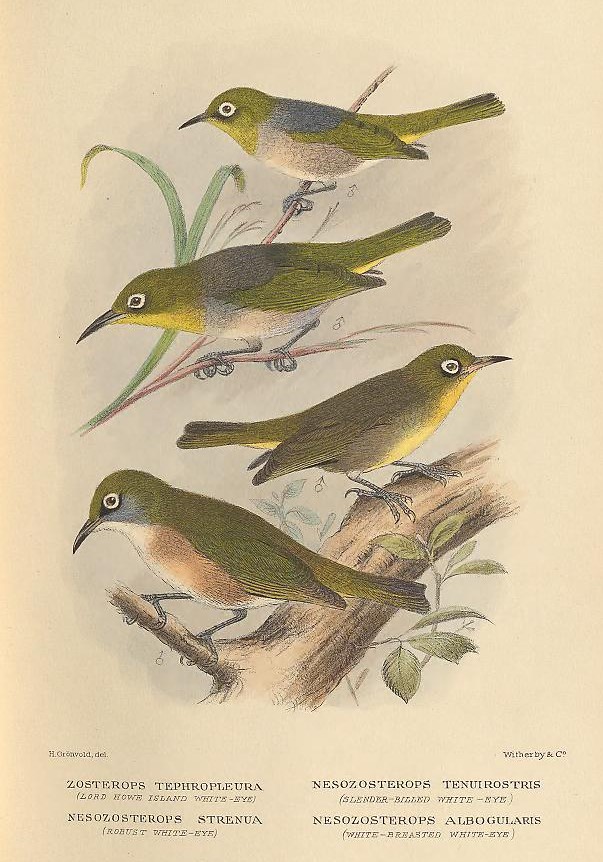Zosterops strenuus Gould, 1855:166
Robust white-eye, Lord Howe white-eye, Lord Howe white eye, Robust silvereye, Big grinnell
Taxonomy & Nomenclature
Synonym/s: Zosterops strenua Gould, 1855:166; Zosterops tenuirostris strenuus Gould, 1855:166; Nesozosterops strenua Gould, 1855:166
Conservation Status
Extinct (WCMC, 1992:212)
Last record: 1908 (BirdLife International, 2012); 1918 (Kittelberger et al., 2024); 1928 (WCMC, 1992:212)
IUCN RedList status: Extinct
Distribution
Lord Howe Island, New South Wales, Australia
Biology & Ecology
Hypodigm
Holotype: BMNH 1855.10.23.2 (adult, female)
Other specimens:
[url=http://nlbif.eti.uva.nl/naturalis/detail.php?lang=uk&id=19]RMNH 110.011[/url]
[url=http://nlbif.eti.uva.nl/naturalis/detail.php?lang=uk&id=19]RMNH 110.012[/url] (adult)
Media

Above: illustration from Mathews (1928).
References
Original scientific description:
Gould, John. (1855). On some new species of birds collected by Mr McGillivray. Proceedings of the Zoological Society of London 1855(23): 164-166.
Other references:
BirdLife International. (2012). Zosterops strenuus. In: IUCN 2012. IUCN Red List of Threatened Species. Version 2012.2. (http://www.iucnredlist.org). Downloaded on 19 May 2013.
BirdLife International. 2016. Zosterops strenuus. The IUCN Red List of Threatened Species 2016: e.T22714223A94406811. https://dx.doi.org/10.2305/IUCN.UK.2016-3.RLTS.T22714223A94406811.en. Accessed on 30 June 2022.
Brooks, T. 2000. Extinct species. In: BirdLife International (ed.), Threatened Birds of the World, pp. 701-708. Lynx Edicions and BirdLife International, Barcelona and Cambridge, U.K.
Christidis, L. and Boles, W.E. 2008. Systematics and Taxonomy of Australian Birds. CSIRO Publishing, Collingwood, Australia.
Day, David. (1981). The Doomsday Book of Animals: A Natural History of Vanished Species. New York, N.Y.: The Viking Press.
Department of Environment and Climate Change (NSW). (2007). Lord Howe Island Biodiversity Management Plan Appendices. Department of Environment and Climate Change (NSW), Sydney. vii + 267 pp.
Fuller, Errol. (1988). Extinct Birds. New York: Facts on File Publications. 256 pp.
Garnett, Stephen (ed.). (1992). Threatened and Extinct Birds of Australia. RAOU Report Number 82. 212 pp.
Garnett, S. T. and Crowley, G. M. (2000). The Action Plan for Australian Birds 2000. Canberra, ACT: Environment Australia & Birds Australia.
Garnett, S. T.; Szabo, J. K.; Dutson, G. 2011. The Action Plan for Australian Birds 2010. CSIRO Publishing, Collingwood.
Greenway James C. (1967). Extinct and Vanishing Birds of the World. American Committee for International Wild Life Protection, Special Publication no 13, 2nd edn. Dover Publications, New York.
Hindwood, Keith A. (1938). The extinct birds of Lord Howe Island. Australian Museum Magazine 6(9): 319-324.
Hindwood, Keith A. (1940). The birds of Lord Howe Island. Emu 40: 1-86.
del Hoyo, J., Collar, N.J., Christie, D.A., Elliott, A., Fishpool, L.D.C., Boesman, P. and Kirwan, G.M. 2016. HBW and BirdLife International Illustrated Checklist of the Birds of the World. Volume 2: Passerines. Lynx Edicions and BirdLife International, Barcelona, Spain and Cambridge, UK.
Hull, Arthur Francis Basset. (1909). The birds of Lord Howe and Norfolk Islands. Proceedings of the Linnean Society of New South Wales 34: 636-693, pls. l-liv. [p. 690]
Hutton, Ian. (1991). Birds of Lord Howe Island: Past and Present. Coffs Harbour Plaza, N.S.W.: Self Published. 154 pp.
Kittelberger, Kyle D., Tanner, Colby J., Buxton, Amy N., Prewett, Amira and Şekercioğlu, Çağan Hakkı. (2024). Correlates of avian extinction timing around the world since 1500 CE. Avian Research 15: 100213. https://doi.org/10.1016/j.avrs.2024.100213 [Supplementary data (List of 216 taxa)]
Knox, Alan G. and Walters, Michael P. (1994). Extinct and endangered birds in the collections of The Natural History Museum. British Ornithologists' Club Occasional Publications 1: 1-292. [pp. 225-226]
Mathews, Gregory Macalister. (1928). The Birds of Norfolk & Lord Howe Islands and the Australasian South Polar Quadrant: with additions to "birds of Australia". London: H.F. & G. Witherby. xii + 139 pp., pls. 1-45. [p. 53, pl. 27]
McAllan, Ian A. W., Curtis, Brian R., Hutton, Ian and Cooper, Richard M. (2004). The Birds of Lord Howe Island Group: A Review of Records. Australian Field Ornithology 21(Supplement): 1-82.
McCulloch, Allan R. (1921). Lord Howe Island–a naturalist's paradise. Australian Museum Magazine 1(2): 31-47.
Mees, G. F. (1969). A systematic review of the Indo-Australian Zosteropidae (Part iii). Zoologische Verhandelingen 102: 1-390.
Recher, H. F. (1974). Colonisation and extinction: the birds of Lord Howe Island. Australian Natural History 18(2): 64-69.
Sayol, Ferran, Steinbauer, Manuel J., Blackburn, Tim M., Antonelli, Alexandre and Faurby, Søren. (2020). Anthropogenic extinctions conceal widespread evolution of flightlessness in birds. Science Advances 6(49): eabb6095. https://doi.org/10.1126/sciadv.abb6095 [Supplementary Material (Data File S1)]
Schodde, R. and Mason, I. J. 1999. The Directory of Australian Birds: Passerines. CSIRO, Collingwood, Victoria.
Sharland, M. S. R. (1929). Land birds of Lord Howe Island. Emu 29: 5-11.
Stattersfield, A.J., Crosby, M.J., Long, A.J. and Wege, D.C. 1998. Endemic bird areas of the world: priorities for bird conservation. BirdLife International, Cambridge, U.K.
Tyrberg, Tommy. (2009). Holocene avian extinctions, pp. 63-106. In: Turvey, Samuel T. (ed.). Holocene Extinctions. Oxford, UK & New York, USA: Oxford University Press. xii + 352 pp.
WCMC (World Conservation Monitoring Centre). (1992). Global Biodiversity: Status of the Earth's living resources. London: Chapman & Hall. xx + 594 pp.
Woinarski, John C. Z., Braby, M. F., Burbidge, A. A., Coates, D., Garnett, S. T., Fensham, R. J., Legge, S. M., McKenzie, N. L., Silcock, J L. and Murphy, B. P. (2019). Reading the black book: The number, timing, distribution and causes of listed extinctions in Australia. Biological Conservation 239: 108261. https://doi.org/10.1016/j.biocon.2019.108261
Woinarski, John C. Z., Legge, Sarah M. and Garnett, Stephen T. (2024). Extinct Australian birds: numbers, characteristics, lessons and prospects. Emu 124(1): 8-20. https://doi.org/10.1080/01584197.2023.2240345
https://extinctanimals.proboards.com/thread/8859/zosterops-strenuus-robust-white-eye
